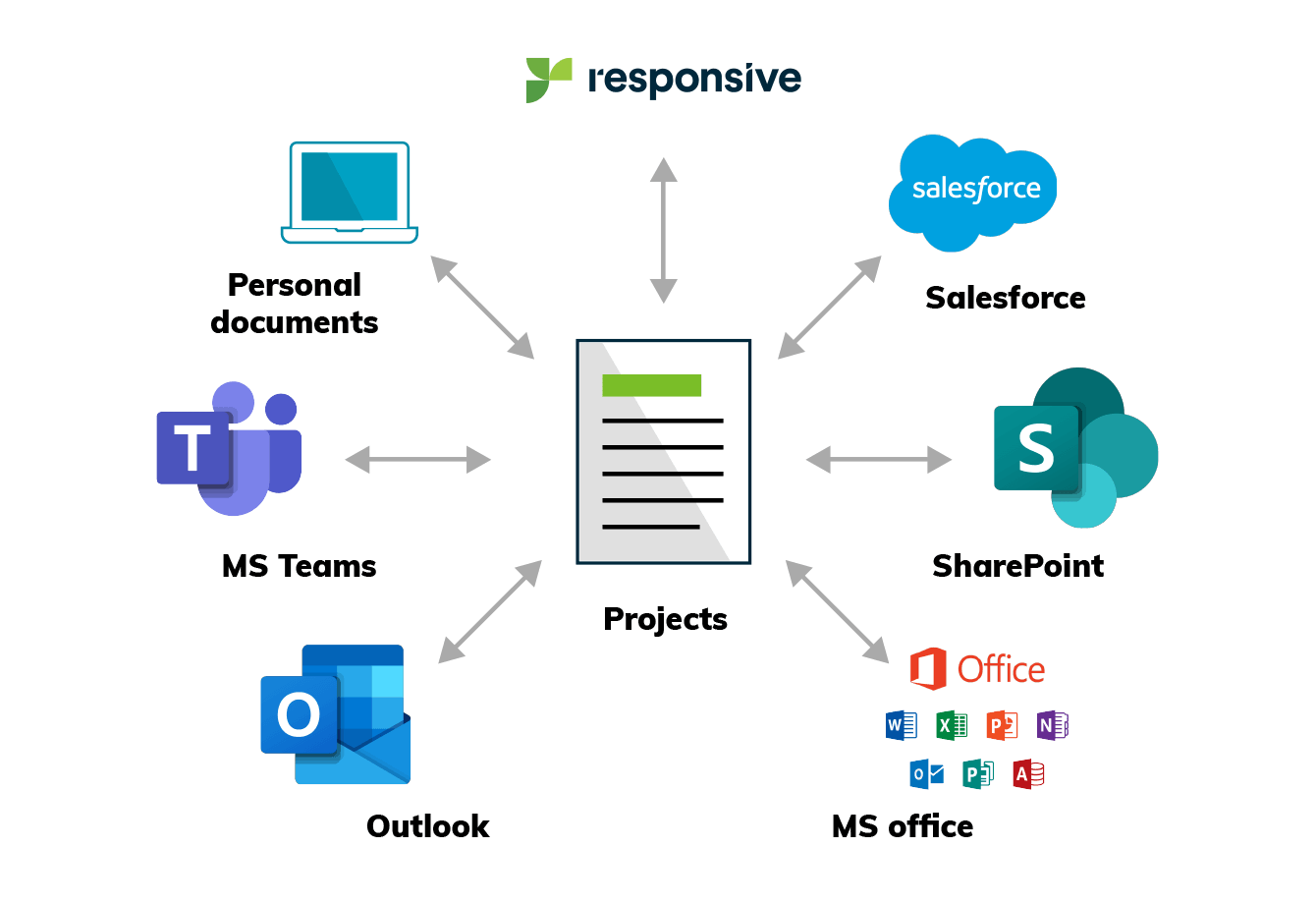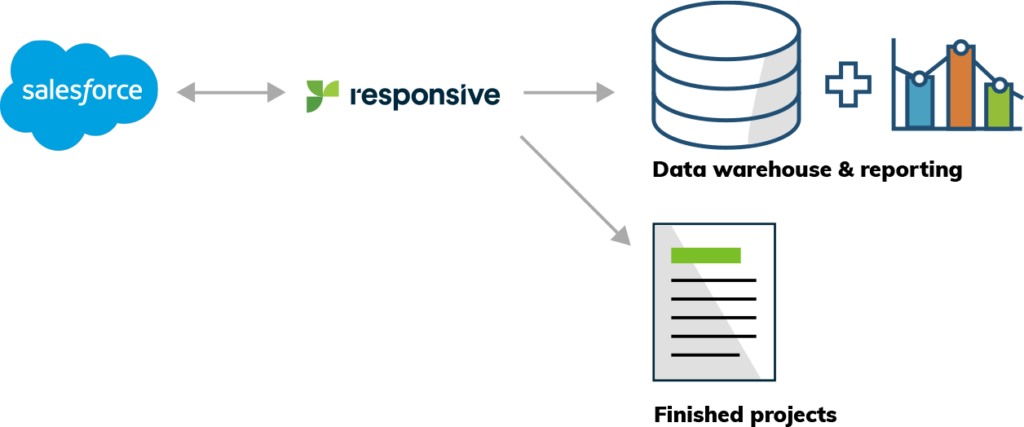We’re living A-to-Z in Responsive to complete our projects now.
– Andrew Mersman Senior Director, Solution Consulting, Netsmart
Netsmart provides software and IT solutions to community-based healthcare providers outside the hospital setting in the U.S. More than 133 million people are impacted by its applications that support electronic health records and health information exchanges. A Responsive customer since 2019, Netsmart’s primary use case of strategic response management (SRM) is to respond to RFPs, which are viewed as the first step to future company revenue.
Results to date:
- 93% of RFPs pass go-forward benchmarks as a result of a trusted Content Library
- 35% increase in RFP responses submitted with 0% increase in proposal team headcount
- More than 320 users from seven teams use the platform
- 98% of Content Library is up to date, accurate and compliant (up from 55% in the previous year)
Netsmart’s Response Challenge
Responsive is designed to scale with your company. The strongest implementations continue to expand platform usage instead of putting it on a shelf. Alas, after purchasing Responsive in 2019, Netsmart’s Content Library started gathering dust and needed attention by 2022:
- Only 754 Q&A pairs
- 45% of content outdated
- 21% content unvetted
- 53% content utilization
Between 2019 when Netsmart started using Responsive and 2022, Netsmart added 13 new products and no new proposal team members. That meant content exploded by a third with minimal governance and support of the Content Library.

Additionally, the proposal team and company subject matter experts were using six other solutions (Microsoft Teams, SharePoint, Salesforce, etc.) as well as Responsive. This resulted in siloed content and knowledge, inefficient collaboration and lack of visibility into the response process.
By the time Andrew Mersman, Senior Director, Solution Consulting at Netsmart, joined the team and analyzed the response process, Netsmart was experiencing serious response challenges, including:
- Inefficient employee experience: Proposal team members, sales and product management associates were at risk of burnout. They were frustrated with untrusted content, repetitive requests and inefficiency. The proposal team felt more reactive than proactive and couldn’t keep up. “Shadow” response teams emerged in other departments. They knew the proposal team was already under a lot of strain, and were attempting to ensure a high-quality RFP response output to advance through the sales process.
- Compliance/brand risk: The Content Library was not viewed as a single source of truth — as much as 66 percent of content could not be trusted. The existence of shadow response teams and siloed content was detrimental to data integrity.
- Revenue risk: “The RFP is the first step of engagement to an opportunity. We want to advance the opportunity quickly to the next phase to bring revenue into the company,” Mersman said. “If we’re stumbling out of the gates, then we’re causing problems for the opportunities and putting future revenue at risk.”
Fortunately, Mersman’s initial analysis was just the first step on Netsmart’s road to a thriving strategic response management function. “We actually had this really cool tool called Responsive, but we were only using a portion of it,” Mersman said.
It was time to take advantage of the platform’s full capabilities and put together a plan to overcome all of their response challenges.
4 steps to strategic response management
Mersman’s plan to fix the RFP response process and mitigate brand and revenue risk included four steps.
- Team realignment. Instead of having the proposal team work in a silo, Netsmart merged the team into the solution consulting department. There, the proposal team would know about new products in real time so RFP responses could reflect Netsmart’s full solution portfolio.
- Start using the new Responsive UI. Netsmart’s Responsive users continued working in the classic Responsive UI even after the new UI was debugged and mainstream. As a result, they were unable to access new features and training, all of which were focused on the new UI.
- Re-implement Responsive. In addition to the new UI, Netsmart sought to clean up their Content Library, update it with content that supported all of their products and establish content governance best practices on the platform.
- Integrate Salesforce. Much of the disconnect between the sales and proposal teams originated in Salesforce. The sales team would have to leave Salesforce to engage the RFP team via a fielder’s choice of applications, causing confusion and frustration about project status and quality.
After completing these four steps, Mersman expected to have a single source of content truth, satisfied users who were committed to the updated process and ongoing content governance to keep the Content Library up to date.
Data-driven evidence of re-implementation success
In less than a year from implementing the new structure, Netsmart saw dramatic results. While the new Responsive UI took some getting used to, ultimately users found it more intuitive and recognized its cutting-edge innovation.
The proposal team — now integrated with solution consulting and the broader client experience team — established a product knowledge handoff process to avoid future content gaps. The Content Library doubled in size, growing from 754 Q&A pairs to 1,550 in 10 months while eliminating almost all outdated content (from 25 percent outdated down to only 2 percent).
As the single source of truth came back into focus, users beyond the RFP team clamored to gain access. More than 320 users — a 540 percent increase — from product management, sales, legal, regulatory and engineering teams now use Responsive. To avoid messaging dissonance that can arise when multiple authors contribute to responses, Netsmart also created a messaging style guide. All of the RFP responses now have a unified voice.

Lastly, the Salesforce integration… Responsive is available on the Salesforce AppExchange and has a seamless integration with the CRM. “It was actually very easy — took not even a half an hour,” Mersman said. The integration enables users to launch Responsive projects directly from Salesforce, eliminating the need to communicate, collaborate or store content on other applications. With the entire response process centralized on Responsive, Netsmart eliminated the need for Teams, Outlook, Office and SharePoint in the RFP response process. “We’re living A-to-Z in Responsive to complete our projects now.”
As part of the ongoing content governance plan Netsmart created, content owners receive three weeks advance notice of when updates are due. They then receive weekly reminders to review the content. This governance has helped streamline content review and content search, eliminating the need for users to search externally or in personal documents for response content.
No more shadow response teams. No more content gaps. No more collaborating across multiple platforms. No more repetitive requests. And a lot more visibility.
Responsive has awesome reporting capabilities. I like to take data, combine it with other elements we pull from Salesforce and other Netsmart systems, and put it all into our data warehouse so we can really start to look at trends.
– Andrew Mersman Senior Director, Solution Consulting, Netsmart
The proposal team uses this visibility to identify bottlenecks and eliminate reactivity while looking for opportunities for proactivity.
Mapping data to business outcomes
After taking the four steps to strategic response management, Netsmart increased project throughput — the number of completed RFPs — by 35 percent without adding headcount. For a company that views the RFP as the first step in a sales cycle leading to company revenue, that marks a significant leap in revenue opportunities.
“Because we have a better library — we have a ‘chain of custody’ of our content to make sure we’re talking about value features [in RFP responses] over just function — our go-forward rate for RFPs is sitting at 93 percent, where last year we were at 65 percent. That’s huge,” Mersman said.
It’s impacting the bottom line at the company because we don’t have the stumbling blocks anymore and are advancing to the next phase of an RFP, which is most likely a demo of our product.
– Andrew Mersman Senior Director, Solution Consulting, Netsmart
Engaging Responsive for support
Achieving this level of success so quickly required valuable contributions from multiple teams. Mersman coordinated a dedicated proposal team, eager solution consulting department and readily available Responsive support team to convert a dysfunctional Content Library into a supercharged strategic response management function.
Netsmart strives to optimize the use of all of its technology tools, and they knew there was room for improvement with Responsive. Mersman initiated the process by setting up frequent calls with their customer success manager (CSM) at Responsive.
The Responsive CSM helped develop a strategy outline and provided ongoing guidance on implementation and best practices. Mersman also recruited internal champions to help accelerate user adoption across the organization. “One of the biggest key ingredients is having a partnership with Responsive. Whenever we reach out, there’s instant communication and transparency. It makes a world of difference in our journey.”
| Before Responsive | After Responsive |
| Only 65% of submitted RFPs were approved for go-forward, due to siloed, confusing, and outdated workflows. | 93% of RFPs pass go-forward benchmarks as a result of a trusted Content Library |
| Potential company revenue reduced because of challenges and lack of visibility for RFP responses | 35% increase in RFP responses submitted with 0% increase in RFP team headcount |
| Only 50 users accessed the Content Library while hundreds more worked in “shadow” response teams | More than 320 users from seven teams use the platform |
| 45% of the Content Library was out of date | 98% of Content Library is up to date, accurate and compliant (up from 55% one year ago) |
| Content Library was missing documents and Q&A pairs relating to all new products added since 2019 | Doubled size of Content Library to accommodate new products and unify response function on the platform |






